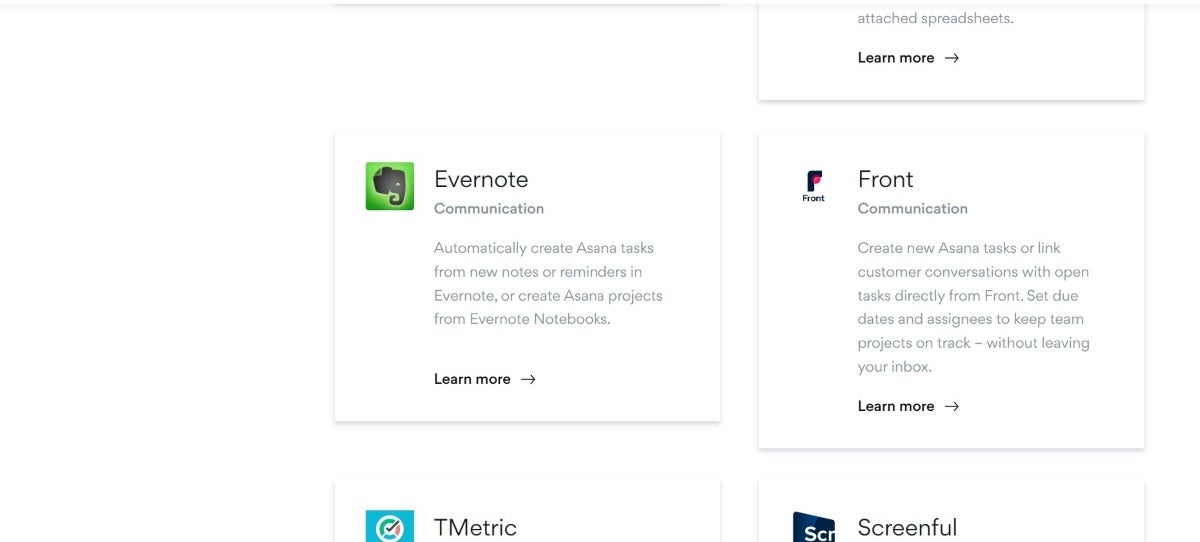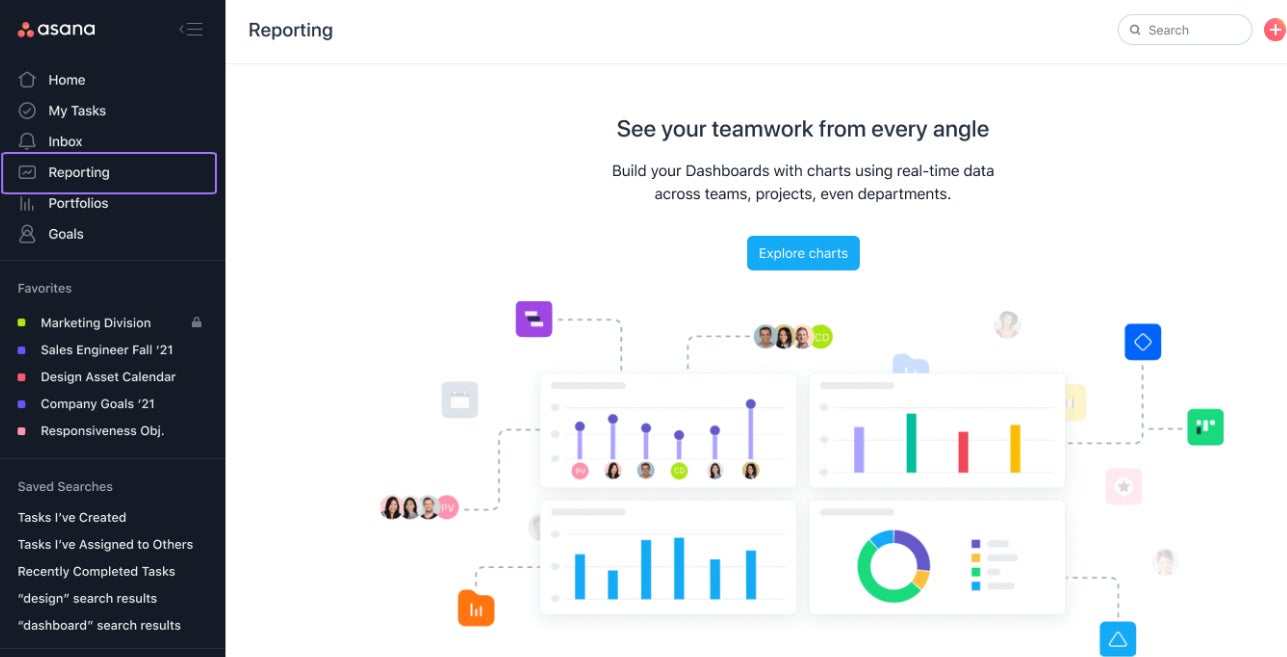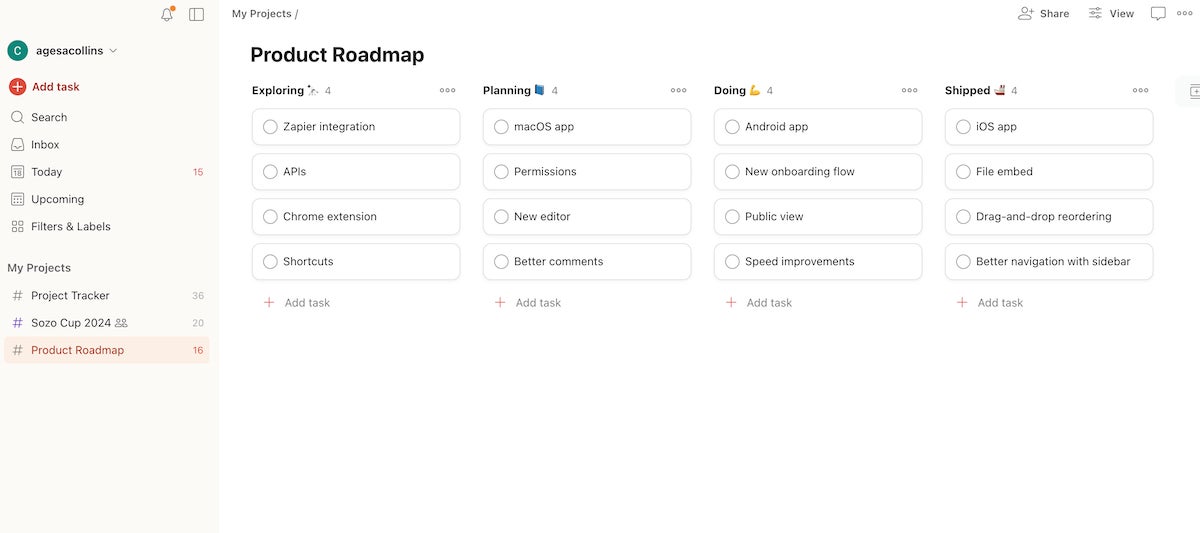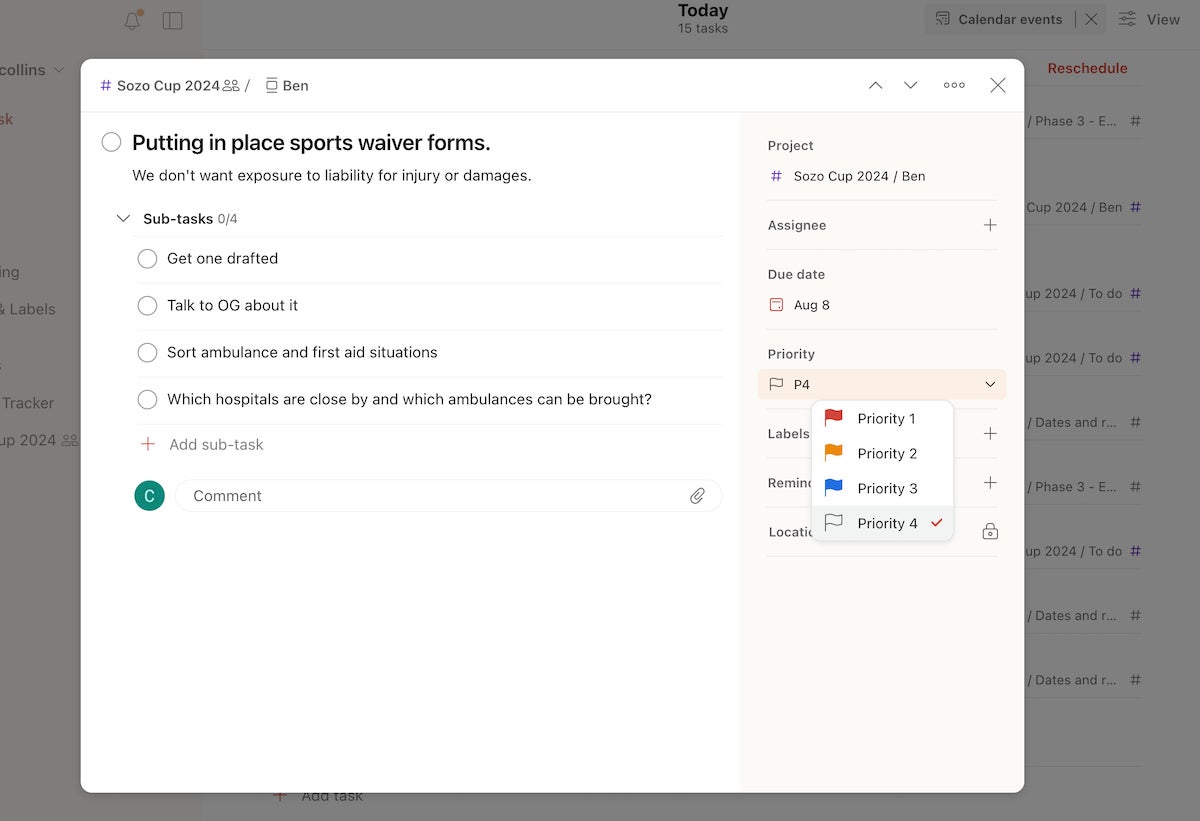When analyzing any project management tool, my top two priorities are always ensuring that the solution fits my budget and offers the functionalities I use regularly. Both Asana and Todoist provide a range of features at affordable prices compared to many other popular project management tools.
I found that these two solutions are not only great for small teams but can also accommodate larger and growing teams that need to collaborate with external partners. Choosing between the two depends on your project requirements and budget.
If budget is your main concern, I’d recommend Todoist. However, if your project requires advanced analytics, Asana might be a better fit.
Asana vs Todoist: comparison table
| Feature | ||
|---|---|---|
| Integrations | ||
| Project management | ||
| Admin tools | ||
| Collaboration | ||
| User interface | ||
| Task prioritization | ||
| Notifications & Reminders | ||
| Mobile application | ||
|
|
Asana vs Todoist pricing
Asana Pricing
Personal
Price: Free
I found Asana’s Personal plan to be a good starting point, offering unlimited tasks, projects, messages, and activity logs for individuals or teams. It also includes different work views like lists, boards, and calendars, making it easy to stay organized.
Starter
Price: $10.99 per user per month billed annually or $13.49 per user if billed monthly.
I love that this plan adds advanced features like timeline views, task dependencies, milestones, and reporting dashboards. These tools really help me keep track of project progress and ensure tasks stay on schedule. Plus, the admin console makes managing teams and permissions much easier.
Advanced
Price: $24.99 per user per month billed annually or $30.49 per user if billed monthly.
This plan includes everything in Premium, plus advanced features like workload management, goals, portfolios, approvals, and integrations with tools like Salesforce and Tableau. I found these extra features particularly useful for managing larger projects that require detailed oversight and more in-depth analytics.
Enterprise
Price: Contact Asana for custom pricing information.
For larger organizations with advanced security and administrative needs, Asana offers an Enterprise plan with features like SAML, user provisioning, data export, and advanced admin controls. These features are perfect for handling sensitive client information and maintaining compliance.
Enterprise+
Price: Contact Asana for custom pricing information.
For organizations that require even more advanced administrative control and support, Asana offers the Enterprise+ plan. This plan provides enhanced support options, including priority support, custom branding, and additional security features. It’s ideal for enterprises with complex needs that require tailored solutions.
For more on Asana, check out our full Asana review or read through our Asana alternatives to see similar tools.
Todoist Pricing
Beginner
Price: Free
Todoist’s Beginner plan includes five projects, five guests, and three filter views. I found it ideal for individuals trying out the software without committing to a paid plan or those who simply want an intuitive free project management software solution.
Pro
Price: $4 per user per month billed annually or $5 per user billed monthly.
The Pro subscription offers 300 active projects, task reminders, and unlimited activity history. I think this plan best suits freelancers or those working with multiple clients, though it lacks a shared workspace for teams.
Business
Price: $6 per user per month billed annually or $8 per user billed monthly.
The Business plan allows for 500 active projects and provides team workspaces, admin roles, and unlimited collaborators, making it a good option for larger teams.
For more information, read our full Todoist review or check out its top alternatives.
Asana vs Todoist features
Integrations
Winner: Tie
In my experience, both Asana and Todoist provide access to integrations that enhance workflows. Todoist offers useful integrations for time tracking, scheduling, automation, and communication with tools like Ganttify, Everhour, Gmail, Outlook, and Slack. Asana provides access to advanced integrations like Tableau, which are only available on higher-tier plans.
Although they’re behind a paywall, Asana is a good choice if you’re looking for diverse and advanced integrations.

Project management
Winner: Tie
Asana offers a broader range of project management features, including templates, task dependencies, reporting, and workload management. I found these features extremely beneficial for managing complex projects. On the other hand, Todoist focuses more on straightforward project needs, such as task reminders, team workspaces, and guest access, which are more affordable and well-suited for simpler projects.
I preferred Todoist for its effectiveness when dealing with small teams and Asana for complex projects.

Admin tools
Winner: Asana
Both tools provide admin and security controls. I appreciate that Asana offers these features across all paid tiers while Todoist restricts them to its Business plan. This means Asana may be better for teams needing comprehensive administrative control from the outset.
Collaboration
Winner: Asana
Collaboration is crucial in any project, and I found Todoist to be quite effective in allowing team members, admins, and guests to work together on projects. Asana, however, offers features like in-app messaging, task dependencies, and templates, which significantly improve teamwork and resource management.
User interface and experience
Winner: Tie
Asana provides a visually rich interface with multiple project views, including a list, board, calendar, and timeline. This flexibility allows me to choose the view that best suits my workflow. However, it was evident that the abundance of features can present a learning curve for new users. On the other hand, Todoist features a minimalist and straightforward design focused on task lists, which makes onboarding quick and easy.

Task prioritization and labels
Winner: Asana
Asana allows me to set task priorities using custom fields and tags, which helps in detailed categorization and filtering. This is particularly beneficial for more complex projects that require nuanced task management. Todoist, however, provides a simple priority system with four levels and allows adding labels to tasks for quick sorting and organization.

Notifications and reminders
Winner: Todoist
While using Asana, I noticed it offers customizable notifications for task updates, deadlines, and comments. However, it lacks built-in reminders for tasks, which might require using third-party integrations.
Todoist includes intuitive built-in reminders and notifications, which helped me stay informed about upcoming deadlines without needing any external tools. Todoist also offers a feature that syncs tasks with date and time to my calendar, making it easy to tweak my calendar to better focus on tasks.
Mobile application functionality
Winner: Todoist
I’ve used both mobile apps, and while Asana provides a mobile app that mirrors much of the desktop functionality, it can feel a bit overwhelming due to the complexity of its features. Todoist, on the other hand, offers a highly responsive and user-friendly mobile app designed for quick task addition and management. This makes Todoist the better option if you frequently work from your mobile device.
Asana pros and cons
Pros
- Excellent project management software features.
- Great for collaboration with multiple unlimited features across all plans.
- Strong security and user permission controls.
- Advanced reporting and analytics tools.
Cons
- Can be expensive for startups.
- Limited integrations depending on the plan.
- Steep learning curve for new users.
- Some advanced features are only available on higher-tier plans.
Todoist pros and cons
Pros
- Affordable plans.
- Intuitive built-in reminders and notifications.
- Simple and user-friendly interface for easy onboarding.
- 90+ integrations available to all plans.
Cons
- Fewer features compared to competitors.
- Lacks advanced reporting and analytics tools.
- Limited collaboration features for larger teams.
- No shared workspace in the Pro plan.
Should you pick Asana or Todoist?
Choose Asana if:
- You need advanced features like workload management, task dependencies, and analytics tools like Tableau.
- Security is a priority for your projects, as Asana offers compliance features like HIPAA.
- You want in-app collaboration with messaging, task dependencies, and templates for resource allocation.
Choose Todoist if:
- Affordability is your main priority for small teams or individuals.
- You need a simple project management software solution with easy onboarding.
- You don’t require advanced reporting or integrations and prefer a straightforward tool for collaboration.
Review methodology
For this review, I examined product pages to get information on features, pricing, integration options, and suitability for different project sizes. I’ve used both platforms extensively myself, with Asana for managing projects for my business with my team and most recently using Todoist to work with various partners to set up an event.
These two real-life use cases informed me about the strengths and shortcomings of each tool, including usability, quality of features, and mobile app.
Frequently asked questions (FAQs)
Is Asana better than Todoist?
Choosing Asana vs Todoist depends on your requirements. I found Asana to be better for teams needing advanced project management tools, while Todoist is great for those looking for a budget-friendly solution. Asana is ideal for handling more complex projects, while Todoist’s simplicity makes it a great choice for smaller tasks.
Does Asana sync with Todoist?
No, Asana and Todoist do not have direct synchronization features. However, you can use third-party integrations like Zapier to create workflows between them. This way, you can connect both tools to streamline your project management workflow.
What is better than Todoist?
The definition of a “better” tool depends on your needs. If you require more advanced project management features, Asana, Trello, or ClickUp might be better options than Todoist. Each of these alternatives provides more comprehensive project management features for complex workflows.
Is Asana still being used?
Yes, Asana is widely used by teams of all sizes for project management and task collaboration. It’s particularly popular among businesses that need robust analytics and workload management features. Many organizations continue to use Asana to streamline their project workflows effectively.
Collins Ayuya updated this article.



